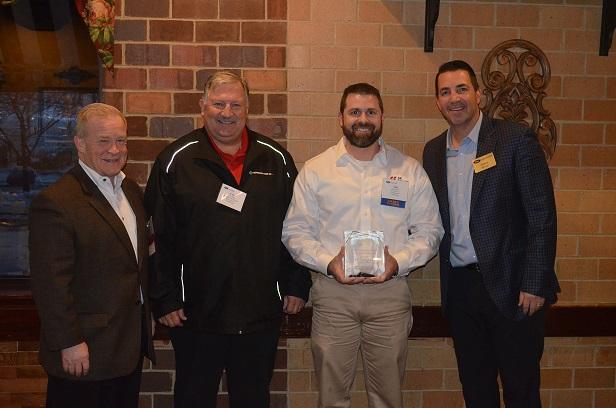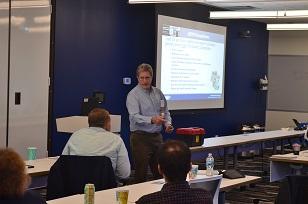Editor-in-Chief
- FMA
- The Fabricator
- FABTECH
- Canadian Metalworking
Categories
- Additive Manufacturing
- Aluminum Welding
- Arc Welding
- Assembly and Joining
- Automation and Robotics
- Bending and Forming
- Consumables
- Cutting and Weld Prep
- Electric Vehicles
- En Español
- Finishing
- Hydroforming
- Laser Cutting
- Laser Welding
- Machining
- Manufacturing Software
- Materials Handling
- Metals/Materials
- Oxyfuel Cutting
- Plasma Cutting
- Power Tools
- Punching and Other Holemaking
- Roll Forming
- Safety
- Sawing
- Shearing
- Shop Management
- Testing and Measuring
- Tube and Pipe Fabrication
- Tube and Pipe Production
- Waterjet Cutting
Industry Directory
Webcasts
Podcasts
FAB 40
Advertise
Subscribe
Account Login
Search
FMA Safety Conference 2018: Improving life on the shop floor, improving the overall business
A safe shop keeps older workers around longer, gets new workers in the door
- By Dan Davis
- April 20, 2018

Nathan Goode, safety manager, AK Tube LLC, Columbus, Ind., accepts FMA’s 2018 Rusty Demeules Award for Safety Excellence from (left to right) Roger Wilson, CNA Insurance, a sponsor of the award and the FMA Safety Conference; Cam Valle, Plymouth Tube, the winner of the same award in 2016 and 2017; and FMA’s Pat Simon. Rusty Demeules, who worked for his family’s metal fabricating company, Standard Iron and Wire Works, in Monticello, Minn., served as president of the FMA/CNA Safety Committee from its inception in 1989 until 1996.
You might wonder why a majority of presentations on the first day of the 10th annual Fabricators & Manufacturers Association Safety Conference focused on the aging work force—the folks heading out the door at most fab shops. When you consider populations dynamics in the U.S., however, this topic is a pretty important one for safety professionals—and the manufacturing community as a whole.
Of course, everyone is aware that about 10,000 people turn 65 every day in the U.S. The media has been good about sharing that particular demographic nugget. That trend will continue until 2030.
What isn’t really discussed is that this trend will continue. During his presentation on the aging work force in manufacturing, Brian Roberts, CNA Insurance’s risk control director, manufacturing and ergonomics, said that from 2000 to 2020 the number of workers aged 55 to 64 is expected to increase by 73 percent. That’s a huge increase when compared to younger demographic segments: 15-24, 8 percent; 25-34, 7 percent; 35-44, -10 percent; and 45-55, 3 percent.
“It’s going to be a constant struggle to find people that will help keep your companies on-cost, on-quality, and on-time,” Roberts said.
With the realization that they will have an older workforce for the immediate future, manufacturers need to ask themselves what they are doing to change the jobs on the shop floor to help extend the work life of their employees. What can be done to reduce heavy lifting? How can work assignments be designed with fewer repetitive movements and static work postures? Can new tools be introduced to help with heavy material movement?
“As a safety professional, I realize that we have done an extremely poor job of explaining to the C-suite the effect that fatigued workers have on overall productivity,” Roberts said.
So if the pool is shrinking for younger workers, manufacturers are going to have to kick up their efforts in recruiting. That means manufacturers have to present themselves as the “manufacturer of choice,” Roberts added.
Frank Cea, Robovent’s director, marketing communications and business development, stressed that point as well. A fabricator with dust-covered equipment and a haze from welding fumes hanging over the shop floor will have a difficult time convincing young people and their parents that manufacturing is a serious career path.
“You have millennials entering the work force, and if they come into a company and see a dirty work environment, they may think about leaving that company and applying for another job down the street,” Cea said.
Any fabricator that doubts the necessity for controlling dust and welding fumes should consider the reality of what is floating around the shop. Cea said that for every 1,000 pounds of welding wire that a fab shop burns through, 10 to 20 pounds of particles, usually 0.1 to 5 microns in size, are produced. Again, manufacturers that don’t control their indoor environment will have a hard time recruiting younger workers.

Doug Raff, vice president, Paragon Industrial Controls Inc., provides an overview of lock-out/tag-out best practices at the FMA Safety Conference.
Attendees of the safety conference also had the opportunity to hear presentations on lock-out/tag-out best practices, OSHA enforcement trends, and tips to build a safety-first culture. They also had the opportunity to tour UL and learn about the different ways the organization ensures many consumer and building products meet safety expectations.
During the conference, FMA announced the availability of its Safety Fundamentals for Metal Manufacturing Certificate. The certificate is the culmination of two days of training that aims to provide individuals with an overview of the FMA/CNA Safety & Loss Control Manual. The course covers common safety issues that confront workers in the typical metal manufacturing environment. Attendees learn about safety standards and best practices for their employees, their facility, and their community. The next certificate course is scheduled for June 12-13 at FMA’s headquarters in Elgin, Ill.
To learn more information about the certificate program or the next FMA Safety Conference, send an e-mail to education@fmanet.org.
subscribe now

The Fabricator is North America's leading magazine for the metal forming and fabricating industry. The magazine delivers the news, technical articles, and case histories that enable fabricators to do their jobs more efficiently. The Fabricator has served the industry since 1970.
start your free subscriptionAbout the Author

Dan Davis
2135 Point Blvd.
Elgin, IL 60123
815-227-8281
Dan Davis is editor-in-chief of The Fabricator, the industry's most widely circulated metal fabricating magazine, and its sister publications, The Tube & Pipe Journal and The Welder. He has been with the publications since April 2002.
- Stay connected from anywhere

Easily access valuable industry resources now with full access to the digital edition of The Fabricator.

Easily access valuable industry resources now with full access to the digital edition of The Welder.

Easily access valuable industry resources now with full access to the digital edition of The Tube and Pipe Journal.
- Podcasting
- Podcast:
- The Fabricator Podcast
- Published:
- 04/30/2024
- Running Time:
- 53:00
Seth Feldman of Iowa-based Wertzbaugher Services joins The Fabricator Podcast to offer his take as a Gen Zer...
- Industry Events
Pipe and Tube Conference
- May 21 - 22, 2024
- Omaha, NE
World-Class Roll Forming Workshop
- June 5 - 6, 2024
- Louisville, KY
Advanced Laser Application Workshop
- June 25 - 27, 2024
- Novi, MI
Precision Press Brake Certificate Course
- July 31 - August 1, 2024
- Elgin,































